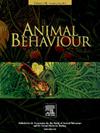Repeatability and intraclass correlations from time-to-event data: towards a standardized approach
IF 2.3
2区 生物学
Q2 BEHAVIORAL SCIENCES
引用次数: 0
Abstract
Many biological features are expressed as ‘time-to-event’ traits, such as time to first reproduction or time to first response to some stimulus. The analysis of these traits frequently produces right-censored data in cases where no event has occurred within a certain time frame. The Cox proportional hazards (CPH) model, a type of survival analysis, accounts for censored data by estimating the hazard of an event occurring at each time point. While random effect variances can be estimated in CPH models, it is currently not possible to estimate within-cluster variance. Consequently, we lack a general method for calculating ecologically and evolutionary relevant variances and metrics like repeatability from time-to-event data. We here present a solution to this issue. We first describe the characteristics of CPH models and introduce repeatability as an intraclass correlation coefficient (ICC). We demonstrate how CPH models with discrete time intervals are comparable to binomial generalized linear mixed-effects models (GLMMs) with the complementary log-log link. Through this equivalence, we show how to estimate an ICC using the estimates of the random effects variance component(s) resulting from CPH models and the distribution-specific variance (within-cluster variance) from the binomial GLMM. We provide a case study and online materials to demonstrate how our new method for ICC for time-to-event data can be implemented and used. We conclude that the proposed method will not only generate a standard way to quantify consistent individual differences (ICC) from time-to-event data, but also broaden the use of survival analysis outside of the typical implementation for survivorship studies.
从时间到事件数据的可重复性和类内相关性:走向标准化的方法
许多生物学特征被表达为“时间到事件”的特征,例如第一次繁殖的时间或对某些刺激的第一次反应的时间。在特定时间框架内没有发生任何事件的情况下,对这些特征的分析通常会产生正确审查的数据。Cox比例风险(CPH)模型是一种生存分析,通过估计每个时间点发生的事件的风险来解释删除的数据。虽然CPH模型可以估计随机效应方差,但目前还无法估计聚类内方差。因此,我们缺乏一种通用的方法来计算生态和进化相关的方差和度量,如从时间到事件的数据的可重复性。我们在此提出解决这个问题的办法。我们首先描述CPH模型的特征,并引入可重复性作为类内相关系数(ICC)。我们证明了具有离散时间间隔的CPH模型如何与具有互补对数-对数链接的二项广义线性混合效应模型(glmm)相比较。通过这种等效性,我们展示了如何使用CPH模型产生的随机效应方差分量和二项GLMM的分布特定方差(簇内方差)的估计来估计ICC。我们提供了一个案例研究和在线材料,以演示如何实现和使用我们的用于事件时间数据的ICC新方法。我们的结论是,所提出的方法不仅可以从时间到事件的数据中产生一种量化一致个体差异(ICC)的标准方法,而且还可以在生存研究的典型实施之外扩大生存分析的使用。
本文章由计算机程序翻译,如有差异,请以英文原文为准。
求助全文
约1分钟内获得全文
求助全文
来源期刊

Animal Behaviour
生物-动物学
CiteScore
4.60
自引率
8.00%
发文量
236
审稿时长
10.2 weeks
期刊介绍:
Growing interest in behavioural biology and the international reputation of Animal Behaviour prompted an expansion to monthly publication in 1989. Animal Behaviour continues to be the journal of choice for biologists, ethologists, psychologists, physiologists, and veterinarians with an interest in the subject.
 求助内容:
求助内容: 应助结果提醒方式:
应助结果提醒方式:


